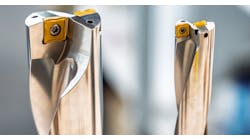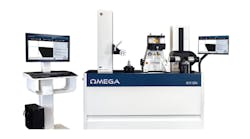Milling/drilling tools raise the bar on cutting effectiveness.
F4033 Xtra-tec face-milling cutters use inserts with eight cutting edges.
The F4042 shoulder mill cuts soft and has plunging capabilities.
Xtra-tec drills are two-effective and feature high-stability insert-clamping.
Plaudits from users of a series of milling and drilling tools include claims of shaft-milling times cut in half, tool lives extended 53%, machining costs down by more than two-thirds, and productivity levels up almost 100%. Such benefits result from one cutting tool manufacturer's precise coordination of insert geometries and coatings, along with tool-body designs.
For its Xtra-tec series of face mills, shoulder mills, and drills, Walter USA, Waukesha, Wis., incorporates high-positive insert geometries for a free-cutting action. All tool bodies allow coolant through the spindle and are made out of high tensile strength tool steel with nickel-plating to resist corrosion and abrasive wear and reduce friction in chip flutes. For better torque transmission, all inserts are secured with TorxPlus insert screws.
Walter's high-performance Tiger-tec inserts for Xtra-tec milling cutters feature optimized carbide grades, geometries and coatings, which result in low carbide consumption. The inserts are available in grades WKP25/WKP35 for steel and cast iron and WAK15 for cast iron. WAK15 is relatively insensitive to temperature fluctuations and therefore well suited for wet milling applications.
Walter's Xtra-tec F4033 face mills have double-sided square inserts that fit cutters in diameters from 1 1 /2 to 8 in.
The insert's negative basic shape and positive top geometry provide stability and high edge security. Additionally, the eight cutting edges provide for economical cutting. The cutters achieve feedrates 3 those of conventional milling cutters, even at 2 X d.o.c., improving chip volume.
In test milling AISI/SAE 4140 annealed steel, a WKP35 carbide grade insert generated increased productivity rates over 100%, as compared with a competitive carbide grade. When machining No 30 B cast iron, the reduced wear on the WAK15 carbide insert, compared with a competitive silicon-nitride-coated insert, resulted in reducing insert costs by more than an 80%.
With an approach angle of 45°, the F4033 face mill diverts most radial forces axially.
A rhombic shape insert with four cutting edges can be utilized by the F4041 shoulder mill for machining cast iron and steel. The inserts have extreme spiral top-geometry providing a smooth running and low power consumption. The F4041 cuts a 90° shoulder eliminating the need for finishing operations and is available in diameters of 1 1 /2 to 6 in. for cutting depths to 0.500 in.
Walter's F4042 shoulder mills with plunging capabilities are for universal applications. The tool mills a true 90° shoulder, eliminating the need for finish passes. Inserts for the F4042 tools, which produce tightly spiraled chips, come in three sizes with positive top geometries and positive axial rakes for free-cutting action along the entire edge. These AD_T-inserts are available for cast iron, steel, stainless steel and non-ferrous materials. A shell-mill-version is available in diameters of 1 1 /2 to 6 in and a Weldon version 1 /2 to 1 1 /2 in.
Walter's Xtra-tec B401x drill series with coolant-through, drill 3, 5, and 7 diameter holes (in semi-standard up to 10 diameter) and are available in diameters from 0.5 to 1.25 in.
The two-effective inserts allow higher feedrates and the high positive geometry leads to a soft cuttingaction and low horsepower consumption. High repeat accuracy and close bore tolerances are achieved through precise positioning of the insert with a self-centering prism-shaped insert and insert-seat. A Torx-Plus clamping screw secures the insert by passing at an oblique angle through the insert. This pulls the insert into its seat for an axially and radially backlash-free fixture.
Soft-Cutting Action Solves Hard-To-Clamp DilemmaKratzer in Offenburg, an automotive shop specializing in machining difficult parts, faced a dilemma when trying to raise pump-case-cover cutting efficiency. The company manufactures about 2 million pump covers/yr. Kratzer had a problem because the pump covers, made of AISI/SAE 5115 from a flat workpiece, had an uneven profile which created clamping difficulties. "Using conventional cutters, the pump case covers were frequently pulled out of the clamping device, limiting d.o.c. to 0.040 in.," explains Jakob Roth, production foreman at Kratzer. "With a stock-removal rate of 0.100 to 0.120 in., two roughing operations were required before finishing. However, using Walter's Xtra-tec F4033 face cutter with high-positive inserts, which provide process reliability even with cutting depths of 0.080 in., we reduced roughing to one operation." As a result, total chip volume improved by 2, as compared with conventional milling cutters, saving Kratzer about $39,000/yr. |






